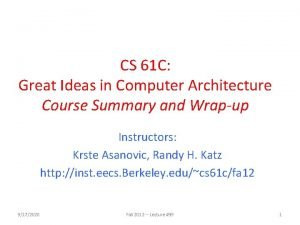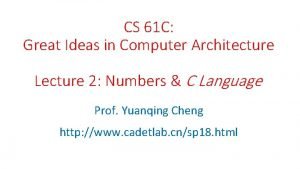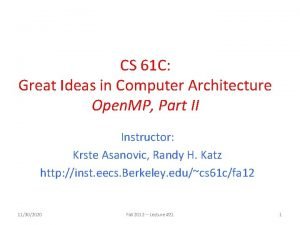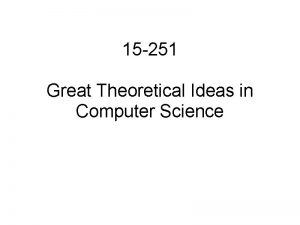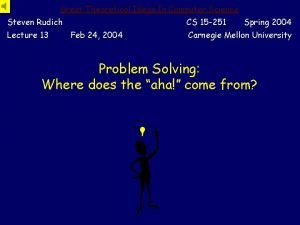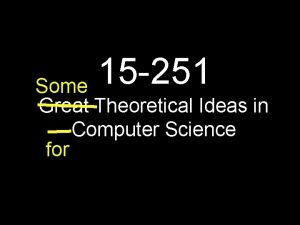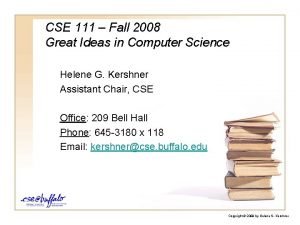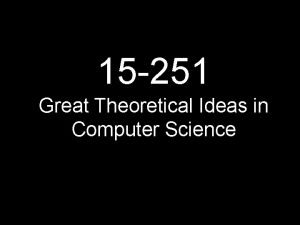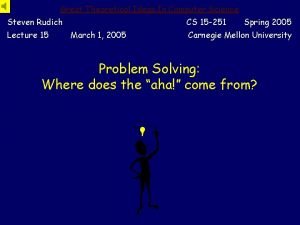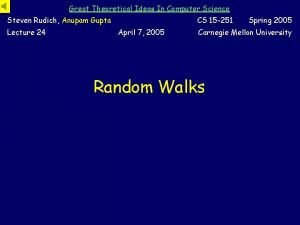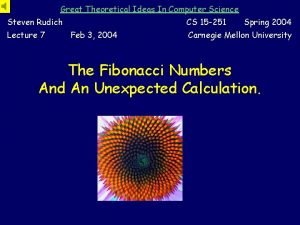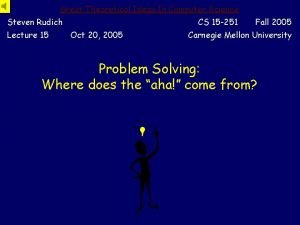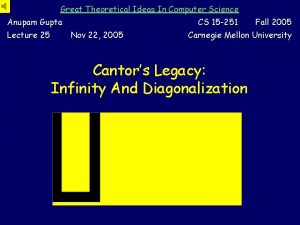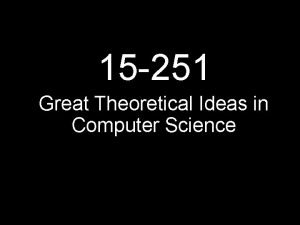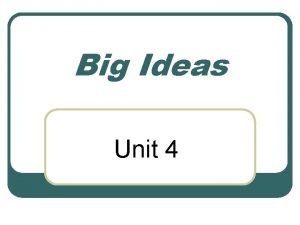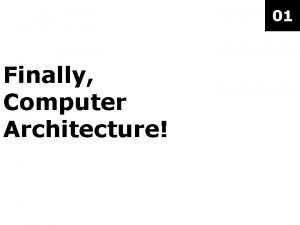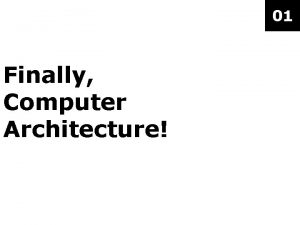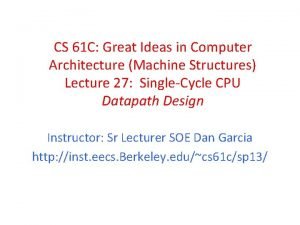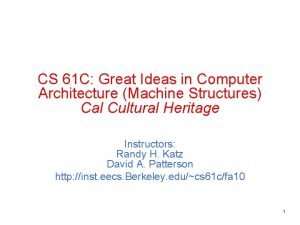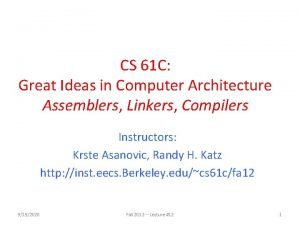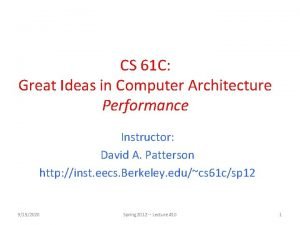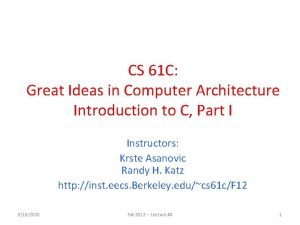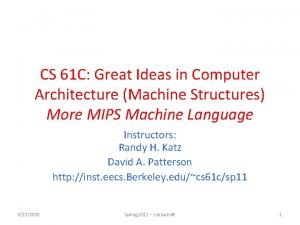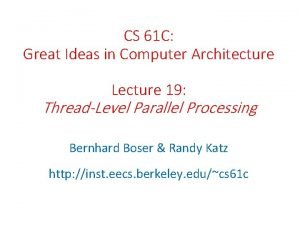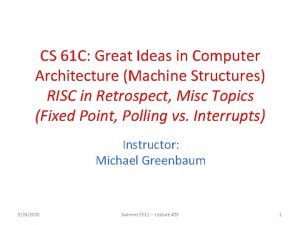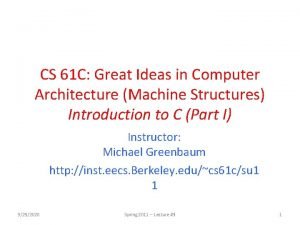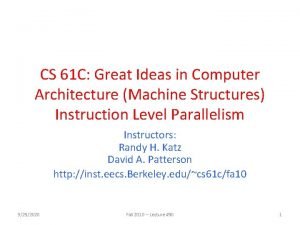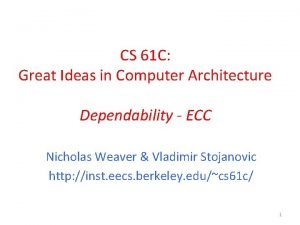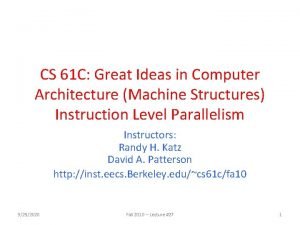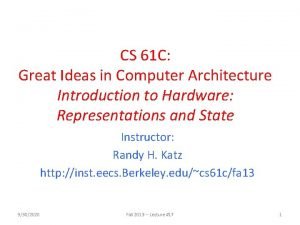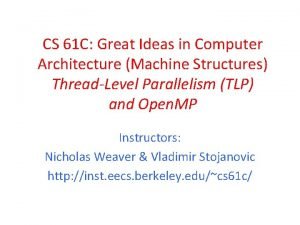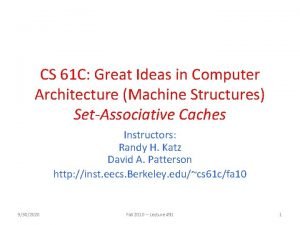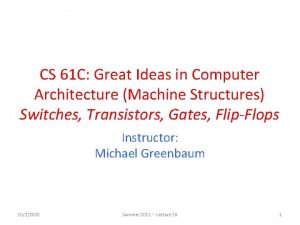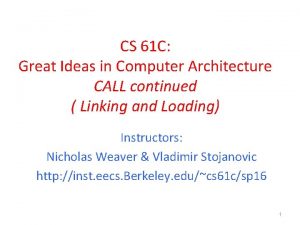CS 61 C Great Ideas in Computer Architecture



















































- Slides: 51

CS 61 C: Great Ideas in Computer Architecture (Machine Structures) Instructors: Randy H. Katz David A. Patterson http: //inst. eecs. Berkeley. edu/~cs 61 c/sp 11 10/3/2020 Spring 2011 -- Lecture #8 1

10/3/2020 Spring 2011 -- Lecture #8 2

New-School Machine Structures (It’s a bit more complicated!) Software • Parallel Requests Assigned to computer e. g. , Search “Katz” • Parallel Threads Assigned to core e. g. , Lookup, Ads Hardware Harness Parallelism & Achieve High Performance Smart Phone Warehouse Scale Computer Today’s Lecture Computer • Parallel Instructions >1 instruction @ one time e. g. , 5 pipelined instructions • Parallel Data >1 data item @ one time e. g. , Add of 4 pairs of words • Hardware descriptions All gates @ one time 10/3/2020 … Core Memory (Cache) Input/Output Instruction Unit(s) Core Functional Unit(s) A 0+B 0 A 1+B 1 A 2+B 2 A 3+B 3 Main Memory Logic Gates Spring 2011 -- Lecture #8 3

Levels of Today’s Representation/Interpretation. Lecture High Level Language Program (e. g. , C) Compiler Assembly Language Program (e. g. , MIPS) Assembler Machine Language Program (MIPS) temp = v[k]; v[k] = v[k+1]; v[k+1] = temp; lw lw sw sw $t 0, 0($2) $t 1, 4($2) $t 1, 0($2) $t 0, 4($2) 0000 1010 1100 0101 1001 1111 0110 1000 1100 0101 1010 0000 Anything can be represented as a number, i. e. , data or instructions 0110 1000 1111 1001 1010 0000 0101 1100 1111 1000 0110 0101 1100 0000 1010 1000 0110 1001 1111 Machine Interpretation Hardware Architecture Description (e. g. , block diagrams) Architecture Implementation Logic Circuit Description (Circuit Schematic Diagrams)Spring 2011 -- Lecture #8 10/3/2020 4

Agenda • Review • Instructions as Numbers • Administrivia – Secret to Getting a Good Job / Good Internship • • • Assemblers Compilers and Linkers Technology Break Compilers vs. Interpreters Compiler Optimization? 10/3/2020 Spring 2011 -- Lecture #8 5

Review • Program can interpret binary number as unsigned integer, two’s complement signed integer, floating point number, ASCII characters, Unicode characters, … • Integers have largest positive and largest negative numbers, but represent all in between – Two’s comp. weirdness is one extra negative num. Integer and floating point operations can lead to results too big to store within their representations: overflow/underflow • Floating point is an approximation of reals – 232 patterns to represent reals from –∞ to +∞ • Everything is a (binary) number in a computer 10/3/2020 Spring 2011 -- Lecture #7 6

Correction • A = (1000000. 0 + 0. 000001) - 1000000. 0 • B = (1000000. 0 - 1000000. 0) + 0. 000001 • In single precision floating point arithmetic, A does not equal B A = 0. 000000, B = 0. 000001 • Floating Point Addition is not Associative! – Integer addition is associative • When does this matter? 10/3/2020 Spring 2011 -- Lecture #8 7

Instructions as Numbers • Instructions are also kept as binary numbers in memory – Stored program concept – As easy to change programs as it is to change data • Register names mapped to numbers • Need to map instruction operation to a part of number 10/3/2020 Spring 2011 -- Lecture #7 8

Instructions as Numbers • addu $t 0, $s 1, $s 2 – Destination register $t 0 is register 8 – Source register $s 1 is register 17 – Source register $s 2 is register 18 – Add unsigned instruction encoded as number 33 0 17 18 8 0 33 000000 10001 10010 01000 00000 100001 6 bits 5 bits 6 bits • Groups of bits call fields (unused field default is 0) • Layout called instruction format • Binary version called machine instruction 10/3/2020 Spring 2011 -- Lecture #7 9

Instructions as Numbers • sll $zero, 0 – $zero is register 0 – Shift amount 0 is 0 – Shift left logical instruction encoded as number 0 0 0 000000 000000 6 bits 5 bits 6 bits • Can also represent machine code as base 16 or base 8 number: 0000 hex, 00000 oct 10/3/2020 Spring 2011 -- Lecture #7 10

Everything in a Computer is Just a Binary Number • Up to program to decide what data means • Example 32 -bit data shown as binary number: 0000 0000 two What does it mean if its treated as 1. Signed integer 2. Unsigned integer 3. Floating point 4. ASCII characters 5. Unicode characters 6. MIPS instruction 10/3/2020 Spring 2011 -- Lecture #7 Student Roulette? 11

Implications of Everything is a Number • Stored program concept – Invented about 1947 (many claim invention) • As easy to change programs as to change data! • Implications? 10/3/2020 Spring 2011 -- Lecture #7 Student Roulette? 12

Names of MIPS fields op rs rt rd shamt funct 6 bits 5 bits 6 bits op: Basic operation of instruction, or opcode rs: 1 st register source operand rt: 2 nd register source operand. rd: register destination operand (result of operation) • shamt: Shift amount. • funct: Function. This field, often called function code, selects the specific variant of the operation in the op field • • 10/3/2020 Spring 2011 -- Lecture #7 13

What about Load, Store, Immediate, Branches, Jumps? • Fields for constants only 5 bits (-16 to +15) – Too small for many common cases • #1 Simplicity favors regularity (all instructions use one format) vs. #3 Make common case fast (multiple instruction formats)? • 4 th Design Principle: Good design demands good compromises • Better to have multiple instruction formats and keep all MIPS instructions same size – All MIPS instructions are 32 bits or 4 bytes 10/3/2020 Spring 2011 -- Lecture #7 14

Names of MIPS Fields in I-type op rs rt address or constant 6 bits 5 bits 16 bits • op: Basic operation of instruction, or opcode • rs: 1 st register source operand • rt: 2 nd register source operand for branches but register destination operand for lw, sw, and immediate operations • Address/constant: 16 -bit two’s complement number – Note: equal in size of rd, shamt, funct fields 10/3/2020 Spring 2011 -- Lecture #7 15

Register (R), Immediate (I), Jump (J) Instruction Formats R-type I-type op rs rt rd shamt funct 6 bits 5 bits 6 bits op rs rt address or constant 6 bits 5 bits 16 bits • Now loads, stores, branches, and immediates can have 16 -bit two’s complement address or constant: -32, 768 (-215) to +32, 767 (215 -1) • What about jump, jump and link? J-type 10/3/2020 op address 6 bits 26 bits Spring 2011 -- Lecture #7 16

Addressing in Branches I-type op rs rt address or constant 6 bits 5 bits 16 bits • Programs much bigger than 216 bytes, but branch address must fit in 16 -bit field – Must specify a register for branch addresses for big programs: PC = Register + Branch address – Which register? • Conditional branching for IF-statement, loops – Tend to be near branches; ½ within 16 instructions • Idea: PC-relative branching 10/3/2020 Spring 2011 -- Lecture #7 17

Addressing in Branches I-type op rs rt address or constant 6 bits 5 bits 16 bits • Hardware increments PC early, so relative address is PC = (PC + 4) + Branch address • Another optimization since all MIPS instructions 4 bytes long? • Multiply value in branch address field by 4! • MIPS PC-relative branching PC = (PC + 4) + (Branch address*4) 10/3/2020 Spring 2011 -- Lecture #7 18

Addressing in Jumps J-type op address 6 bits 26 bits • Same trick for Jumps, Jump and Link PC = Jump address * 4 • Since PC = 32 bits, and Jump address * 4 = 28 bits, what about other 4 bits? • Jump and Link only changes bottom 28 bits of PC 10/3/2020 Spring 2011 -- Lecture #7 19

Encoding of MIPS Instructions: Must Be Unique! Instruction For mat op rs rt rd shamt funct address addu subu sltu sll addi unsigned lw (load word) sw (store word) beq bne j (jump) jal jr (jump reg) R R I I I J J R 0 0 9 ten 35 ten 43 ten 4 ten 5 ten 2 ten 3 ten 0 reg reg n. a. reg reg reg 0 0 0 constant 33 ten 35 ten 43 ten 0 ten n. a. reg reg reg n. a. n. a. n. a. constant address address reg reg 0 8 ten n. a. 10/3/2020 reg Spring 2011 -- Lecture #7 n. a. 20

Agenda • Review • Instructions as Numbers • Administrivia – Secret to Getting a Good Job / Good Internship • • • Assemblers Compilers and Linkers Technology Break Compilers vs. Interpreters Compiler Optimization? 10/3/2020 Spring 2011 -- Lecture #8 21

Secret To Getting Good Job/Internship • Job/Intern interviews are (now) oral exams • Long-term memory vs. short-term/working memory “Long-term memory is intended for storage of information over a long time. Information from the working memory is transferred to it after a few seconds. Unlike in working memory, there is little decay. ” • Learning for recall 6 -`1 months later in oral exam vs. getting grades? – Read before lecture, think about lecture, do assignments, labs , . . ? – Cram day before exam, start project with 24 hours to go? 10/3/2020 Spring 2011 -- Lecture #8 22

Scores on Project 1, Part 1 Distribution: Number grades: 324 0. 0 - 2. 5: 8 * Mean: 22. 0 2. 5 - 5. 0: 1 * 5. 0 - 7. 5: 2 * Mode: 25. 0 7. 5 - 10. 0: 10* Standard deviation: 5. 5 10. 0 - 12. 5: 3 * Minimum: 0. 0 12. 5 - 15. 0: 4 * 1 st quartile: 20. 0 15. 0 - 17. 5: 14 ** 2 nd quartile (median): 25. 0 17. 5 - 20. 0: 5 * 20. 0 - 22. 5: 56 ***…* 3 rd quartile: 25. 0 22. 5 - 25. 0: 4 * Maximum: 25. 0 - 27. 5: 217 *****…* 10/3/2020 Spring 2011 -- Lecture #8 23

Computers In The News • IBM Watson play Jeopardy! with champions – A significant milestone in computing, on par with IBM Deep Blue vs. Kasparov in chess in 1997? • Mon 2/14 – Wed 2/16 7 -7: 30 PM KGO Channel 7 10/3/2020 Spring 2011 -- Lecture #8 http: //www-03. ibm. com/innovation/us/watson 24

My Life Beyond Computing • 1935 Ford Station Wagon • 221 cubic inch (85 HP) original Ford Flathead V 8 Engine 10/3/2020 Spring 2011 -- Lecture #8 25

My Life Beyond Computing • 1938 Ford Cabriolet • 454 cubic inch (7500 cc) “Big Block” Chevy V 8 Engine 10/3/2020 Spring 2011 -- Lecture #8 26

Assembler • Input: Assembly Language Code (e. g. , foo. s for MIPS) • Output: Object Code, information tables (e. g. , foo. o for MIPS) • Reads and Uses Directives • Replace Pseudoinstructions • Produce Machine Language • Creates Object File

Converting C to MIPS Machine code &A=$t 1 (reg 9), $t 0 (reg 8), h=$s 2 (reg 18) A[300] = h + A[300]; Format? lw $t 0, 1200($t 1) _ addu $t 0, $s 2, $t 0 _ sw $t 0, 1200($t 1) R-type I-type J-type 10/3/2020 op op op Student Roulette? _ rs rs rt rt Spring 2011 -- Lecture #7 rd shamt funct address or constant address 28

Converting C to MIPS Machine code &A=$t 1 (reg 9), $t 0 (reg 8), h=$s 2 (reg 18) A[300] = h + A[300]; Format? lw $t 0, 1200($t 1) _I addu $t 0, $s 2, $t 0 _ sw $t 0, 1200($t 1) R-type I-type J-type 10/3/2020 op op op Student Roulette? 9 _ rs rs 1200 8 rt rt Spring 2011 -- Lecture #7 rd shamt funct address or constant address 29

Converting C to MIPS Machine code &A=$t 1 (reg 9), $t 0 (reg 8), h=$s 2 (reg 18) A[300] = h + A[300]; Format? lw $t 0, 1200($t 1) I_ addu $t 0, $s 2, $t 0 R_ sw $t 0, 1200($t 1) R-type I-type J-type 10/3/2020 op op op Student Roulette? 9 18 8 _ rs rs 1200 8 rt rt Spring 2011 -- Lecture #7 8 0 rd shamt funct address or constant address 30

Converting C to MIPS Machine code &A=$t 1 (reg 9), $t 0 (reg 8), h=$s 2 (reg 18) A[300] = h + A[300]; Format? lw $t 0, 1200($t 1) _ addu $t 0, $s 2, $t 0 _ 18 sw $t 0, 1200($t 1) 9 Instruction For mat Student Roulette? 9 _ 1200 8 8 8 0 1200 8 op rs rt rd shamt funct address addu R lw (load word) I sw (store word) I 0 35 ten 43 ten reg reg 0 33 ten n. a. address R-type I-type J-type op op op 10/3/2020 rs rs rt rt Spring 2011 -- Lecture #7 rd shamt funct address or constant address 31

Converting C to MIPS Machine code &A=$t 1 (reg 9), $t 0 (reg 8), h=$s 2 (reg 18) A[300] = h + A[300]; Format? lw $t 0, 1200($t 1) _ addu $t 0, $s 2, $t 0 _ 18 sw $t 0, 1200($t 1) 9 Instruction For mat Student Roulette? 9 _ 1200 8 8 8 0 1200 8 op rs rt rd shamt funct address addu R lw (load word) I sw (store word) I 0 35 ten 43 ten reg reg 0 33 ten n. a. address R-type I-type J-type op op op 10/3/2020 rs rs rt rt Spring 2011 -- Lecture #7 rd shamt funct address or constant address 32

Converting C to MIPS Machine code &A=$t 1 (reg 9), $t 0 (reg 8), h=$s 2 (reg 18) A[300] = h + A[300]; Format? lw $t 0, 1200($t 1) _ addu $t 0, $s 2, $t 0 _ 18 sw $t 0, 1200($t 1) 9 Instruction For mat Student Roulette? 9 _ 1200 8 0 1200 8 op rs rt rd shamt funct address addu R lw (load word) I sw (store word) I 0 35 ten 43 ten reg reg 0 33 ten n. a. address R-type I-type J-type op op op 10/3/2020 rs rs rt rt Spring 2011 -- Lecture #7 rd shamt funct address or constant address 33

Converting to MIPS Machine code Add Loop: ress Format? 800 sll $t 1, $s 3, 2 804 addu $t 1, $s 6 808 lw $t 0, 0($t 1) 812 bne $t 0, $s 5, Exit _ _ 816 addiu $s 3, 1 820 j Loop Exit: _ _ R-type I-type J-type 10/3/2020 op op op rs rs rt rt Spring 2011 -- Lecture #7 rd shamt funct address or constant address 34

Converting to MIPS Machine code Add Loop: ress Format? 800 sll $t 1, $s 3, 2 804 addu $t 1, $s 6 808 lw $t 0, 0($t 1) 812 bne $t 0, $s 5, Exit R 0 0 19 9 2 0 R 0 9 22 9 0 33 I 35 9 8 0 I 5 8 21 2 816 addiu $s 3, 1 820 j Loop Exit: I 8 19 19 1 J 2 R-type I-type J-type 10/3/2020 op op op rs rs rt rt 200 rd shamt funct address or constant address Spring 2011 -- Lecture #7 35

32 bit constants in MIPS • Can create a 32 -bit constant from two 32 -bit MIPS instructions • Load Upper Immediate (lui or “Louie”) puts 16 bits into upper 16 bits of destination register • MIPS to load 32 -bit constant into register $s 0? 0000 0011 1101 0000 1001 0000 two lui $s 0, 61 # 61 = 0000 0011 1101 two ori $s 0, 2304 # 2304 = 0000 1001 0000 two 10/3/2020 Spring 2011 -- Lecture #7 36

§ 2. 12 Translating and Starting a Program Translation Many compilers produce object modules directly 10/3/2020 Spring 2011 -- Lecture #8 37

Assembly and Pseudo-instructions • Turning textual MIPS instructions into machine code called assembly, program called assembler – Calculates addresses, maps register names to numbers, produces binary machine language – Textual language called assembly language • Can also accept instructions convenient for programmer but not in hardware – Load immediate (li) allows 32 -bit constants, assembler turns into lui + ori (if needed) – Load double (ld) uses two lwc 1 instructions to load a pair of 32 -bit floating point registers – Called Pseudo-Instructions 10/3/2020 Spring 2011 -- Lecture #8 38

Assembler Directives (p. B-5 to B-7) • Give directions to assembler, but do not produce machine instructions. text: Subsequent items put in user text segment. data: Subsequent items put in user data segment. globl sym: declares sym global and can be referenced from other files. asciiz str: Store the string str in memory and null-terminate it. word w 1…wn: Store the n 32 -bit quantities in successive memory words

Assembler Pseudoinstructions • Most assembler instructions represent machine instructions one-to-one • Pseudoinstructions: figments of the assembler’s imagination → add $t 0, $zero, $t 1 blt $t 0, $t 1, L → slt $at, $t 0, $t 1 move $t 0, $t 1 bne $at, $zero, L – $at (register 1): assembler temporary Spring 2011 -- Lecture #8 10/3/2020 40

More Pseudoinstructions Student Roulette? • Asm. treats convenient variations of machine language instructions as if real instructions Pseudo: Real: addu $t 0, $t 6, 1 subu $sp, 32 sd $a 0, 32($sp) la $a 0, str ______________ _______

More Pseudoinstructions Student Roulette? • Asm. treats convenient variations of machine language instructions as if real instructions Pseudo: Real: addu $t 0, $t 6, 1 subu $sp, 32 sd $a 0, 32($sp) la $a 0, str addiu $t 0, $t 6, 1 ______________

More Pseudoinstructions Student Roulette? • Asm. treats convenient variations of machine language instructions as if real instructions Pseudo: Real: addu $t 0, $t 6, 1 subu $sp, 32 sd $a 0, 32($sp) la $a 0, str addiu $t 0, $t 6, 1 addiu $sp, -32 ______________

More Pseudoinstructions Student Roulette? • Asm. treats convenient variations of machine language instructions as if real instructions Pseudo: Real: addu $t 0, $t 6, 1 subu $sp, 32 sd $a 0, 32($sp) la $a 0, str addiu $t 0, $t 6, 1 addiu $sp, -32 sw $a 0, 32($sp) sw $a 1, 36($sp) lui $at, left(str) ori $a 0, $at, right(str)

Producing an Object Module • Assembler (or compiler) translates program into machine instructions • Provides information for building a complete program from the pieces – Header: described contents of object module – Text segment: translated instructions – Static data segment: data allocated for the life of the program – Relocation info: for contents that depend on absolute location of loaded program – Symbol table: global definitions and external refs – Debug info: for associating with source code 10/3/2020 Spring 2011 -- Lecture #8 45

Separate Compilation and Assembly • No need to compile all code at once • How put pieces together? FIGURE B. 1. 1 The process that produces an executable file. An assembler translates a file of assembly language into an object file, which is linked with other files and libraries into an executable file. Copyright © 2009 Elsevier, Inc. All rights reserved. 10/3/2020 Spring 2011 -- Lecture #8 46

§ 2. 12 Translating and Starting a Program Translation and Startup Many compilers produce object modules directly Static linking 10/3/2020 Spring 2011 -- Lecture #8 47

Linker Stitches Files Together FIGURE B. 3. 1 The linker searches a collection of object fi les and program libraries to find nonlocal routines used in a program, combines them into a single executable file, and resolves references between routines in different files. Copyright © 2009 Elsevier, Inc. All rights reserved. 10/3/2020 Spring 2011 -- Lecture #8 48

Linking Object Modules • Produces an executable image 1. Merges segments 2. Resolve labels (determine their addresses) 3. Patch location-dependent and external refs • Often a slower than compiling – all the machine code files must be read into memory and linked together Spring 2011 -- Lecture #8 10/3/2020 49

Loading a Program • Load from image file on disk into memory 1. 2. 3. 4. 5. 6. Read header to determine segment sizes Create virtual address space (cover later in semester) Copy text and initialized data into memory Set up arguments on stack Initialize registers (including $sp, $fp, $gp) Jump to startup routine • Copies arguments to $a 0, … and calls main • When main returns, do “exit” systems call 10/3/2020 Spring 2011 -- Lecture #8 50

Review • Everything is a (binary) number in a computer – Instructions and data; stored program concept • Assemblers can enhance machine instruction set to help assembly-language programmer • Translate from text that easy for programmers to understand into code that machine executes efficiently: Compilers, Assemblers • Linkers allow separate translation of modules • Interpreters for debugging, but slow execution • Hybrid (Java): Compiler + Interpreter to try to get best of both • Compiler Optimization to relieve programmer 10/3/2020 Spring 2011 -- Lecture #8 51
 8 ideas of computer architecture
8 ideas of computer architecture 8 great ideas in computer architecture
8 great ideas in computer architecture Cs61c
Cs61c 8 great ideas in computer architecture
8 great ideas in computer architecture Great theoretical ideas in computer science
Great theoretical ideas in computer science Great ideas in theoretical computer science
Great ideas in theoretical computer science Great theoretical ideas in computer science
Great theoretical ideas in computer science Great ideas in computer science
Great ideas in computer science Great theoretical ideas in computer science
Great theoretical ideas in computer science Great theoretical ideas in computer science
Great theoretical ideas in computer science Great theoretical ideas in computer science
Great theoretical ideas in computer science Great theoretical ideas in computer science
Great theoretical ideas in computer science Great theoretical ideas in computer science
Great theoretical ideas in computer science Great theoretical ideas in computer science
Great theoretical ideas in computer science Great theoretical ideas in computer science
Great theoretical ideas in computer science Three bus architecture
Three bus architecture Difference computer organization and architecture
Difference computer organization and architecture Register in computer organization
Register in computer organization Ideas have consequences bad ideas have victims
Ideas have consequences bad ideas have victims Ideas secundarias
Ideas secundarias China big idea
China big idea Turning great strategy into great performance
Turning great strategy into great performance South dakota state symbols
South dakota state symbols Great leader comes great responsibility
Great leader comes great responsibility Great hammerhead vs great white size
Great hammerhead vs great white size Does alexander the great deserve his title
Does alexander the great deserve his title Enlightened despot catherine
Enlightened despot catherine With great expectations comes great responsibility
With great expectations comes great responsibility A great deal vs a great many
A great deal vs a great many With great power comes great responsibility
With great power comes great responsibility Did alexander the great deserve to be called great
Did alexander the great deserve to be called great Great is thy faithfulness o lord my father
Great is thy faithfulness o lord my father Architecture business cycle activities
Architecture business cycle activities Call and return architecture in software engineering
Call and return architecture in software engineering Product architecture design
Product architecture design Integral architecture example
Integral architecture example Computer organization and architecture 10th solution
Computer organization and architecture 10th solution Fast desktop for architecture software
Fast desktop for architecture software Vlab iit kharagpur
Vlab iit kharagpur Introduction to computer organization and architecture
Introduction to computer organization and architecture Timing and control in computer architecture
Timing and control in computer architecture Evolution of computer architecture
Evolution of computer architecture Dma controller in computer architecture
Dma controller in computer architecture Fp adder
Fp adder Addressing mode in computer architecture
Addressing mode in computer architecture Static interconnection network in computer architecture
Static interconnection network in computer architecture Smt in computer architecture
Smt in computer architecture Mips li instruction
Mips li instruction 111011-100100
111011-100100 Instruction format in computer architecture
Instruction format in computer architecture Nano programming in computer organization
Nano programming in computer organization Microprogram sequencing
Microprogram sequencing

